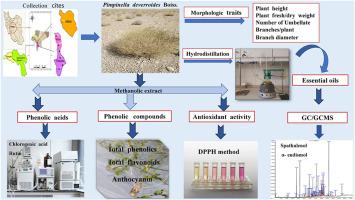Unveiling chemical and morphological variation in Pimpinella deverroides Boiss.: Insights into Iranian populations and essential oil chemotypes
IF 2
4区 生物学
Q4 BIOCHEMISTRY & MOLECULAR BIOLOGY
引用次数: 0
Abstract
Pimpinella deverroides Boiss. is an important aromatic plant belonging to the Apiaceae family. This study aimed to evaluate the morphological, phytochemical, and essential oils (EOs) variations among nine Iranian Pimpinella deverroides populations (PDPs). Significant variation was observed in morphological traits, as well as in the total contents of phenols, anthocyanins, carotenoids, and chlorophyll. Among the studied populations, PDP4 exhibited superior performance in terms of plant height (108 ± 1.15 cm), number of umbellate (212.3 ± 4.05), plant fresh weight (1048 ± 5.77 g), and plant dry weight (592 ± 4.61 g). The EOs and phenolic acids extracted from air-dried aerial parts were analyzed using chromatographic techniques including GC, GC/MS and HPLC. The highest contents of rutin (2.57 ± 0.035 mg/g DW) and chlorogenic acid (12.43 ± 0.057 mg/g DW) were found in PDP3 and PDP5, respectively. In total, thirty-one compounds representing 90.34–96.73 % of the total EOs composition were identified, with twenty-two compounds shared across all populations. Spathulenol (2.07–17.31 %), γ-eudesmol (1.63–11.91 %), oleic acid (5.02–10.73 %), and δ-cadinene (1.00–7.73 %) were the major compounds identified in the EOs. Oxygenated sesquiterpenes (28.71–47.36 %) and hydrocarbon sesquiterpenes (21.78–35.45 %) were the main groups of compounds in the studied EOs. Three main chemotypes were found to be Chemotype I (spiro[4.4] nona-1,6-diene, valernanone), Chemotype II (oleic acid/spathulenol) and Chemotype III (δ-cadinene, δ-elemene). These findings provide valuable insights for the conservation, utilization, and breeding of superior PDPs for further exploitation and the production of attributed herbal products.

揭示了斑蝽的化学和形态变异。:了解伊朗人口和精油化学型
Pimpinella verroides Boiss。是蜂科重要的芳香植物。本研究旨在评价9个伊朗黑毛小蠊种群(pdp)形态、植物化学和精油(EOs)的差异。在形态性状、酚类物质、花青素、类胡萝卜素和叶绿素的总含量方面存在显著差异。其中,PDP4在株高(108±1.15 cm)、伞形花序数(212.3±4.05)、鲜重(1048±5.77 g)和干重(592±4.61 g)方面表现优异。采用气相色谱(GC)、气相色谱/质谱(GC/MS)和高效液相色谱(HPLC)等色谱技术对风干航空部件中提取的EOs和酚酸进行分析。其中芦丁(2.57±0.035 mg/g DW)和绿原酸(12.43±0.057 mg/g DW)含量最高的是PDP3和PDP5。共鉴定出31种化合物,占总成分的90.34 - 96.73%,其中22种化合物为所有种群共有。主要化合物为Spathulenol(2.07 - 17.31%)、γ-eudesmol(1.63 - 11.91%)、油酸(5.02 - 10.73%)和δ-cadinene(1.00 - 7.73%)。氧化倍半萜(28.71 ~ 47.36%)和烃类倍半萜(21.78 ~ 35.45%)是所研究的EOs中主要的化合物类群。三种主要的化学型分别是化学型I(螺[4.4]nona-1,6-二烯,缬草纳米酮),化学型II(油酸/spathulenol)和化学型III (δ-cadine, δ-榄香烯)。这些发现为优质pdp的保护、利用和育种提供了有价值的见解,为进一步开发和生产特色草药产品提供了依据。
本文章由计算机程序翻译,如有差异,请以英文原文为准。
求助全文
约1分钟内获得全文
求助全文
来源期刊

Biochemical Systematics and Ecology
生物-进化生物学
CiteScore
3.00
自引率
12.50%
发文量
147
审稿时长
43 days
期刊介绍:
Biochemical Systematics and Ecology is devoted to the publication of original papers and reviews, both submitted and invited, in two subject areas: I) the application of biochemistry to problems relating to systematic biology of organisms (biochemical systematics); II) the role of biochemistry in interactions between organisms or between an organism and its environment (biochemical ecology).
In the Biochemical Systematics subject area, comparative studies of the distribution of (secondary) metabolites within a wider taxon (e.g. genus or family) are welcome. Comparative studies, encompassing multiple accessions of each of the taxa within their distribution are particularly encouraged. Welcome are also studies combining classical chemosystematic studies (such as comparative HPLC-MS or GC-MS investigations) with (macro-) molecular phylogenetic studies. Studies that involve the comparative use of compounds to help differentiate among species such as adulterants or substitutes that illustrate the applied use of chemosystematics are welcome. In contrast, studies solely employing macromolecular phylogenetic techniques (gene sequences, RAPD studies etc.) will be considered out of scope. Discouraged are manuscripts that report known or new compounds from a single source taxon without addressing a systematic hypothesis. Also considered out of scope are studies using outdated and hard to reproduce macromolecular techniques such as RAPDs in combination with standard chemosystematic techniques such as GC-FID and GC-MS.
 求助内容:
求助内容: 应助结果提醒方式:
应助结果提醒方式:


